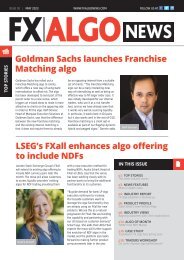You also want an ePaper? Increase the reach of your titles
YUMPU automatically turns print PDFs into web optimized ePapers that Google loves.
FX Liquidity Management: Addressing the challenges of a seriously complex undertaking<br />
TRADING OPERATIONS<br />
novel offerings on existing platforms.<br />
That makes access to a neutral<br />
third-party technology partner with<br />
the ability to help manage a range<br />
of products and liquidity at scale<br />
in highly volatile FX markets more<br />
important than ever,” says Totten.<br />
At the same time, the role of the FX<br />
liquidity manager has evolved, says<br />
Totten. “It is no longer enough for FX<br />
liquidity managers to simply quote<br />
tight spreads - which is hard enough<br />
anyway in the volatile currency<br />
markets seen since the end of the<br />
zero rates era. Skew sensitivity,<br />
skew leakage and analysis of market<br />
impact are all vital factors to evaluate<br />
for both makers and takers to<br />
achieve the best execution.”<br />
oneZero has developed a range of<br />
tools to measure skew effectiveness<br />
and automatically identify clients<br />
with high market impact to help<br />
liquidity managers allocate their<br />
time and resources to the areas<br />
where they can make the largest<br />
impact, underlining why technology<br />
has become so important to the FX<br />
Liquidity Management process, says<br />
Totten.<br />
“The sheer volume of market data<br />
and the growing number of market<br />
“AI is set to transform a sector that is already benefiting<br />
from sophisticated execution algorithms and increasingly<br />
quantitative analysis for both pre- and post-trade liquidity<br />
management, for example.”<br />
Stephen Totten<br />
participants mean that it is now<br />
impossible to function without<br />
advanced analytics. At oneZero we<br />
are currently seeing 2.5x the data<br />
that we were just 18 months ago,<br />
for example. We regularly handle<br />
over 10 million transactions a day<br />
and averaged more than 9 trillion of<br />
quotes a month last year and data<br />
volumes are set to rise further,” he<br />
says.<br />
“Some market players are struggling<br />
with this, so having a technology<br />
stack that can handle scale is<br />
absolutely crucial. Apart from<br />
regulatory needs that are nonnegotiable,<br />
liquidity managers can<br />
also use new analytical tools to<br />
adjust to market conditions more<br />
quickly, which drives customer<br />
revenues and delivers quantifiable<br />
dollar benefits. Data analytical tools<br />
are already the only way to tackle<br />
most of the key challenges facing FX<br />
liquidity managers. And AI is set to<br />
speed the pace of progress in helping<br />
technology solutions evolve to give<br />
liquidity managers an advantage over<br />
their competitors,” says Totten.<br />
It is also useful for FX trading firms to<br />
try to audit their existing FX Liquidity<br />
Management activities, says Totten.<br />
“Every FX firm needs to audit its<br />
liquidity management outcomes and<br />
plan for improvement. If an ECN or<br />
a bank price maker has a key goal<br />
such as winning a higher wallet<br />
share or reducing market impact,<br />
then that has to be measured, for<br />
example. And if the goal is not met<br />
then the liquidity manager needs to<br />
understand what has happened and<br />
why.”<br />
Technology doesn’t displace relationships in FX Liquidity Management<br />
Despite all the talk of technology,<br />
relationships are vital in FX Liquidity<br />
Management and Totten believes<br />
that the right use of technology<br />
can improve rather than detract<br />
form that relationship. “Technology<br />
doesn’t displace relationships in FX<br />
Liquidity Management, it enhances<br />
their efficiency. Faster transmission<br />
of data, interactive feedback on new<br />
liquidity pools or order types and<br />
greater use of quantitative metrics<br />
all help FX liquidity managers to do<br />
their job better.”<br />
18 JULY 20<strong>23</strong> e-FOREX
















